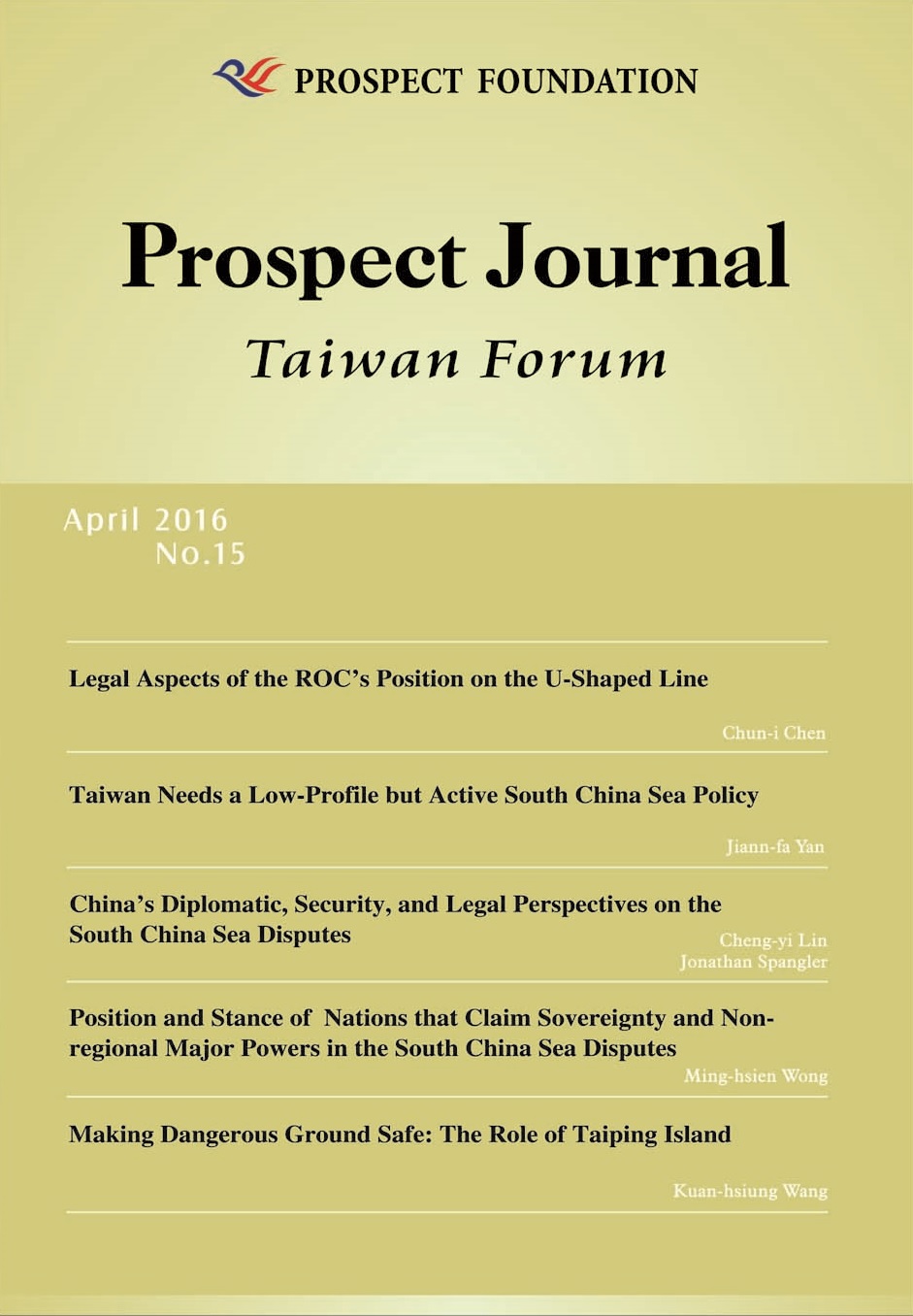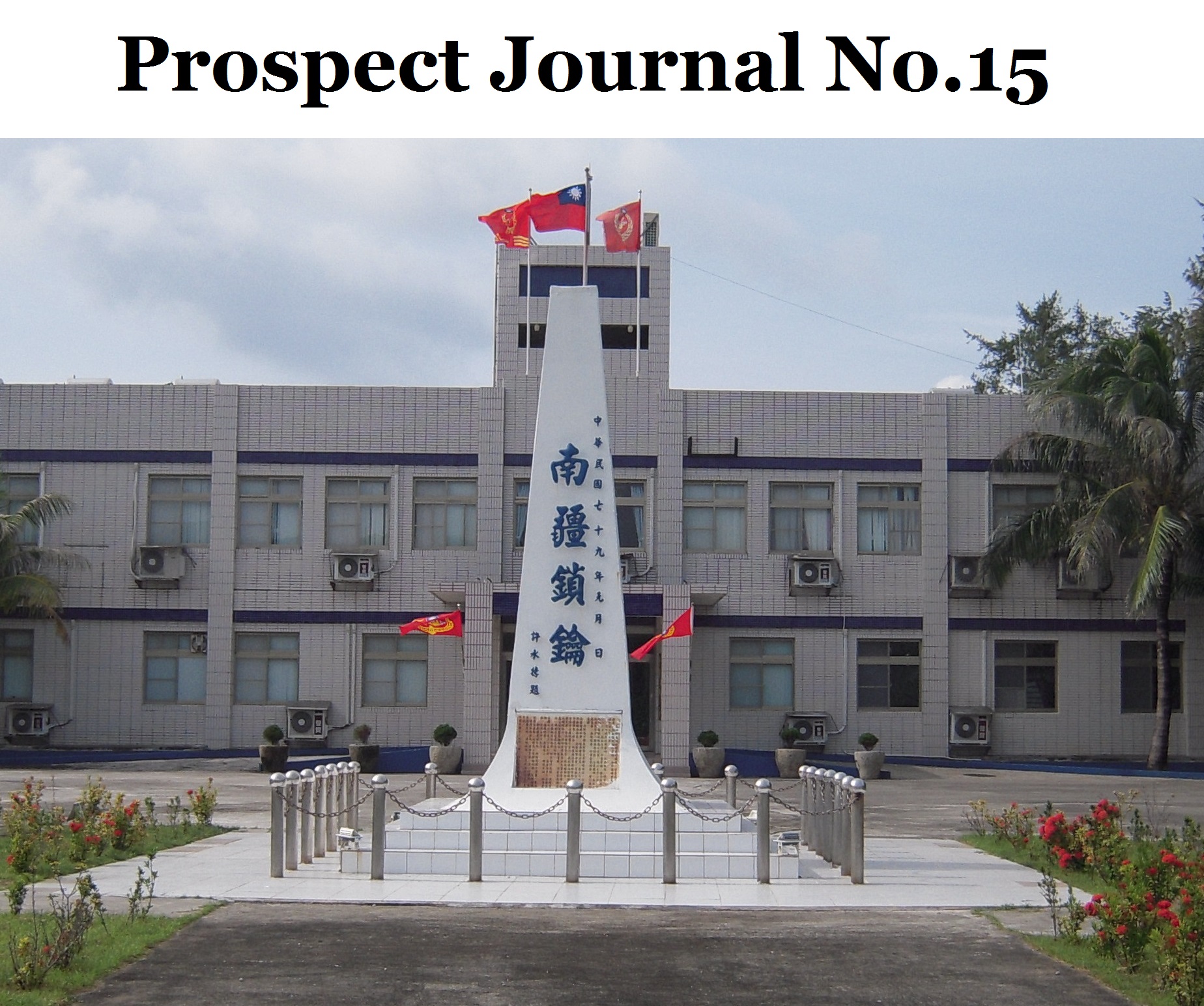Legal Aspects of the ROC's Position on the U-Shaped Line
- PDFLegal Aspects of the ROCs Position on the U-Shaped Line--Chun-i Chen.PDF
- PDFTaiwan Needs a Low-Profile but Active South China Sea Policy--Jiann-fa Yan.PDF
- PDFChinas Diplomatic、Security、and Legal Perspectives on the South China Sea Disputes--Cheng-yi Lin、Jonathan Spangler.PDF
- PDFPosition and Stance of Nations that Claim Sovereignty and Non-regional Major Powers in the South China Sea Disputes--Ming-hsien Wong.pdf
- PDFMaking Dangerous Ground Safe-The Role of Taiping Island--Kuan-hsiung Wang.PDF
Prospect Journal No.15 (April 2016)
Since 2013 the South China Sea disputes have become a hot spot in the Asia-Pacific area. Taiwan could play a more contributive role and promote the peaceful joint cooperation and development of the South China Sea from Taiping Island. Resource: Executive Yuan Taiwan(R.O.C.), Executive Yuan,
With mainland China's rise, South China Sea disputes have become a focal point around the world. This issue of the Journal features essays by invited scholars who are long-term observers of South China Sea politics and international relations. In their articles, policy suggestions are provided to serve as a reference for think tanks worldwide.
Legal Aspects of the ROC's Position on the U-Shaped Line
Department of Diplomacy and Department of Law,
National Chengchi University
Abstract
In 1947, the Republic of China (ROC) government published a map on which a "U-Shaped Line" was drawn to enclose the four groups of islands, a large part of the waters, and other features of the South China Sea. The "U-Shaped Line" has been a pivotal focus in the South China Sea's territorial and maritime boundary delimitation disputes since 2009. Its legality was challenged by the Philippines in an arbitration case in 2013. This paper analyzes the legal aspects of the ROC's position on the "U-Shaped Line." It first provides a brief background on the history of the line. Then, it reviews a variety of interpretations on the legal status of the "U-Shaped Line" with special reference to the ROC's state practices. After examining implications of the "U-Shaped Line" on the South China Sea disputes, some observations are made in the conclusion section.
Keywords:U-Shaped Line, South China Sea, UNCLOS, Historic Waters, Taiping Island
Taiwan Needs a Low-Profile but Active South China Sea Policy
Professor, Department of Business Administration,
Chien Hsin University of Science and Technology
With its military presence in the South China Sea, Taiwan is one of the stakeholders. Taiwan's presence is solid, owing to the balance of power in the region, even though Taiwan's voice is not loud enough. Taiwan's geo-political value with invisibility and silence sometimes means great potential. The author argues that an interestbased approach would be much more helpful than a rights-based one in resolving the disputes. More dialogue and negotiation can serve long-term interests for the involved parties, even though the way of dialogue has been overshadowed by a confrontational approach. A negative approach will make the involved parties exacerbate their harm to each other; it will also destabilize the region. The author suggests that Taiwan needs a more holistic self-assessment in dealing with the South China Sea issues instead of following the examples of the Philippines and Vietnam. Taiwan may find another way of "de-militarization" and "non-political" participation. This is the time for Taiwan's government to actively manage this issue and make the existence of the islands more substantial before Taiwan is marginalized. Hence, Taiwan requires a top-level design to work out a new grand strategy with workable measures taking international laws and real politics into consideration.
Keywords: South China Sea, UNCLOS, Taiping Island, Taiwan, East China Sea Peace Initiative
China's Diplomatic, Security, and Legal Perspectives on the South China Sea Disputes
Academia Sinica
Jonathan Spangler
Director, South China Sea Think Tank,
Asia-Pacific Policy Research Association
Despite China's high-profile role in the South China Sea maritime territorial disputes, Beijing's perspectives are often misunderstood within the international community. With the aim of bringing clarity to the issue, this article discusses China's viewpoint on the disputes from diplomatic, security, and legal angles. From a diplomatic perspective, Beijing acknowledges that disputes exist in the South China Sea, favors bilateral negotiations for dispute settlement, is steadfast in its promotion of non-interference in regional relations, has no choice but to always take the Taiwan factor into consideration, and is forced more often than it wishes to engage in tit-for-tat, reactionary diplomatic behavior. From a security perspective, China holds that it has exercised remarkable restraint in the face of security threats and has argued, albeit unconvincingly, that its development efforts on disputed features are primarily for civilian purposes. From a legal perspective, the article assesses the PRC's position with regards to international maritime law following the 1982 signing of the United Nations Convention on the Law of the Sea and in the context of the ongoing international arbitration case unilaterally initiated by the Philippines in 2013 under Annex VII of the Convention, in which China has declined to participate. It then concludes with a discussion of the implications of the article and suggests that there is a need for a more comprehensive understanding of Beijing's diplomatic, security, and legal perspectives within the international community if there is ever to be a resolution to the South China Sea disputes that does not seriously damage the interests of one stakeholder or another.
Keywords: Chinese Maritime Policy, International Law, Maritime Security, Maritime Territorial Disputes, South China Sea
Position and Stance of Nations that Claim Sovereignty and Non-regional Major Powers in the South China Sea Disputes
Since 2013 the South China Sea disputes have become a hot spot in the Asia-Pacific area. On the one hand, China has sped up the construction of its artificial island in the Spratly Islands and militarized its man-made islands. On the other hand, the U.S. has acted on its principle of Freedom of Navigation Operations and deployed warships and aircraft in the 12 nautical mile zone around the manmade islands leading to military confrontation between the U.S. and China in the South China Sea. Furthermore, the Philippines has submitted the sovereignty dispute regarding the Spratly Islands to the UN Permanent Court of Justice and after hearings in October 2015 and according to the de jure procedure of this case the verdict will be released in May 2016. But China has already stated that the Court of Justice has no right to handle Chinese sovereignty issues and China will refuse to accept the outcome according to the UN Law of the Sea. Although China did not want to join the arbitration and was absent during the hearings, the outcome of this arbitration will set a precedent for the claimant nations around the South China Sea. In addition, non-regional major powers, such as Japan, India and Australia have their own purposes to engage with different claimant nations in order to counter China's changing the status-quo and increase their interest in the South China Sea. Firstly, this paper describes the current situation in the South China Sea and points out three factors which impact development in the South China Sea. The paper also presents the policy and stance of states which claim sovereignty and those that do not in the South China Sea. Finally, this paper sums up previous descriptions and points out Taiwan's strategy and policy in the South China Sea disputes.
Keywords: Militarization, Maintain Status-Quo, Freedom of Navigation, Changing the Status-Quo, Artificial Island
Download
Making Dangerous Ground Safe: The Role of Taiping Island
In the South China Sea Arbitration, the Philippine argument on the legal status of Taiping Island is just a tactic that does not contribute to actual resolution of disputes in the region. By challenging the legal status of Taiping Island, the Philippines is in fact undermining its own case with a misleading interpretation of the UNCLOS as well as of judgments from other international judicial bodies. Moreover, such an argument creates more conflicts and misunderstandings between claimants than it could deal with, which would make the South China Sea disputes more intricate. With fresh water wells, natural vegetation, agricultural products, a lighthouse, wharf, communications equipment, a hospital, as well as Guanyin Temple, the naturally formed Taiping Island has become a solid foundation for a peaceful South China Sea, and a perfect showcase of the ROC government's long-time peaceful efforts in the region and the model for easing tensions in the South China Sea. The absurd defense provided by the Philippines in the arbitration is not only disrespectful of Taiwan, but also threatens the peaceful resolution of the South China Sea disputes. This paper suggests that Taiwan could play a more contributive role and promote the peaceful joint cooperation and development of the South China Sea from Taiping Island. Claimants should pay more attention to nontraditional security cooperation matters with a zonal perspective.
Keywords: Taiping Island, South China Sea Arbitral Tribunal, Taiwan, Peace Initiative, Regime of Island
Download







